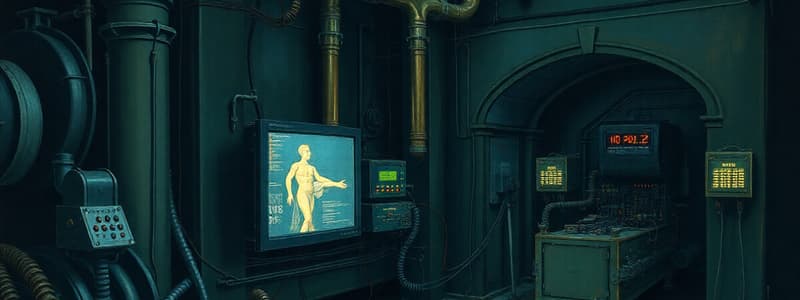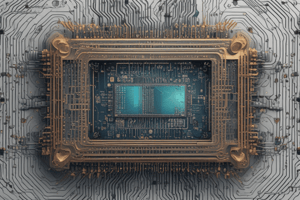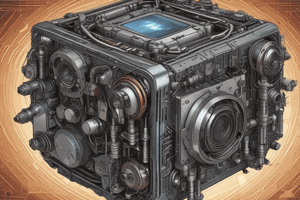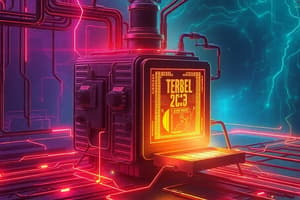Podcast
Questions and Answers
What is the primary reason for connecting SCRs in series?
What is the primary reason for connecting SCRs in series?
- To fulfill high voltage demand (correct)
- To ensure equal voltage distribution
- To simplify circuit design
- To achieve high current demand
What does a derating factor (DRF) signify in relation to string efficiency?
What does a derating factor (DRF) signify in relation to string efficiency?
- It measures the static resistance across each SCR
- It indicates the maximum voltage that can be applied
- It relates to the turn ON time of SCRs
- It determines the required number of SCRs for reliability (correct)
What is the impact of unequal dynamic characteristics on SCR voltage distribution during operation?
What is the impact of unequal dynamic characteristics on SCR voltage distribution during operation?
- It can cause unequal voltage distribution during transient conditions (correct)
- It enhances the reliability of the SCR string
- It ensures the same voltage distribution across all SCRs
- It eliminates the need for equalizing circuits
What is the purpose of the state equalizing circuit in SCR operation?
What is the purpose of the state equalizing circuit in SCR operation?
If SCR1 has higher leakage resistance than SCR2, what will be the effect on the voltage distribution?
If SCR1 has higher leakage resistance than SCR2, what will be the effect on the voltage distribution?
During steady-state operation, how can a uniform voltage distribution be achieved across multiple SCRs?
During steady-state operation, how can a uniform voltage distribution be achieved across multiple SCRs?
What primarily determines the voltage distribution across SCRs during the turn ON and turn OFF processes?
What primarily determines the voltage distribution across SCRs during the turn ON and turn OFF processes?
How does the choice of shunt capacitance (C) affect SCR operation during turn ON and turn OFF processes?
How does the choice of shunt capacitance (C) affect SCR operation during turn ON and turn OFF processes?
What mechanism is utilized by firing circuits to synchronize the firing angles of SCRs in series operation?
What mechanism is utilized by firing circuits to synchronize the firing angles of SCRs in series operation?
In parallel SCR operation, what crucial aspect must the firing circuit manage to maintain system efficiency?
In parallel SCR operation, what crucial aspect must the firing circuit manage to maintain system efficiency?
What effect does the damping resistor have during SCR operation?
What effect does the damping resistor have during SCR operation?
What is the primary purpose of using equalizing circuits in electronic systems?
What is the primary purpose of using equalizing circuits in electronic systems?
During which condition is the voltage unbalance among SCRs more significant?
During which condition is the voltage unbalance among SCRs more significant?
What is the primary purpose of static equalizing circuits?
What is the primary purpose of static equalizing circuits?
Which of the following best describes an active balancing circuit?
Which of the following best describes an active balancing circuit?
How do feedback control systems contribute to current equalization in parallel-connected SCRs?
How do feedback control systems contribute to current equalization in parallel-connected SCRs?
What technique helps to mitigate reverse current flow in inactive SCRs?
What technique helps to mitigate reverse current flow in inactive SCRs?
What is a disadvantage of using resistors for current equalization in SCRs?
What is a disadvantage of using resistors for current equalization in SCRs?
When static and dynamic equalization methods are combined, what advantage does this provide?
When static and dynamic equalization methods are combined, what advantage does this provide?
What role do current transformers play in equalizing current among SCRs?
What role do current transformers play in equalizing current among SCRs?
What is the term 'string efficiency' commonly referred to in the context of?
What is the term 'string efficiency' commonly referred to in the context of?
Which method is not a technique for equalizing current in parallel-connected SCRs?
Which method is not a technique for equalizing current in parallel-connected SCRs?
What is the primary impact of shading on a solar PV string?
What is the primary impact of shading on a solar PV string?
How does mismatch in solar panels affect string efficiency?
How does mismatch in solar panels affect string efficiency?
What is a significant factor that can lead to increased temperature affecting solar panels?
What is a significant factor that can lead to increased temperature affecting solar panels?
Which of the following would NOT improve string efficiency?
Which of the following would NOT improve string efficiency?
How is string efficiency typically expressed?
How is string efficiency typically expressed?
What is the purpose of de-rating factors in engineering applications?
What is the purpose of de-rating factors in engineering applications?
Which of the following is an example of temperature de-rating?
Which of the following is an example of temperature de-rating?
What does altitude de-rating specifically address?
What does altitude de-rating specifically address?
What is the consequence of current de-rating?
What is the consequence of current de-rating?
Why is regular monitoring of solar PV systems important?
Why is regular monitoring of solar PV systems important?
What is the primary purpose of using de-rating factors in engineering design?
What is the primary purpose of using de-rating factors in engineering design?
Which protection method is used primarily to mitigate rapid changes in voltage (dv/dt) for SCRs?
Which protection method is used primarily to mitigate rapid changes in voltage (dv/dt) for SCRs?
What is one of the ideal characteristics of an over-voltage protection (OVP) circuit?
What is one of the ideal characteristics of an over-voltage protection (OVP) circuit?
What is the function of a snubber circuit in relation to SCRs?
What is the function of a snubber circuit in relation to SCRs?
How does gate resistance provide protection against high dv/dt for SCRs?
How does gate resistance provide protection against high dv/dt for SCRs?
What does a crowbar circuit do in over-voltage protection?
What does a crowbar circuit do in over-voltage protection?
Which scenario might lead to an over-voltage condition in a power supply?
Which scenario might lead to an over-voltage condition in a power supply?
Which method of voltage protection can lead to false trips if not designed properly?
Which method of voltage protection can lead to false trips if not designed properly?
Flashcards
Series Connection of SCRs
Series Connection of SCRs
Connecting SCRs in series to handle higher voltages than a single SCR can manage.
String Efficiency
String Efficiency
A measure of how well SCRs in a series string utilize the total voltage.
Derating Factor (DRF)
Derating Factor (DRF)
The difference between ideal and actual efficiency of a series connected SCR string.
Unequal Voltage Sharing
Unequal Voltage Sharing
Signup and view all the flashcards
State Equalizing Circuit
State Equalizing Circuit
Signup and view all the flashcards
Transient Voltage Distribution
Transient Voltage Distribution
Signup and view all the flashcards
SCR Series Connection
SCR Series Connection
Signup and view all the flashcards
Reverse Recovery
Reverse Recovery
Signup and view all the flashcards
Dynamic Equalizing Circuit
Dynamic Equalizing Circuit
Signup and view all the flashcards
Firing Circuit (Series)
Firing Circuit (Series)
Signup and view all the flashcards
Firing Circuit (Parallel)
Firing Circuit (Parallel)
Signup and view all the flashcards
Voltage Unbalance (Turn-Off)
Voltage Unbalance (Turn-Off)
Signup and view all the flashcards
Shunt Capacitance
Shunt Capacitance
Signup and view all the flashcards
Static Equalization
Static Equalization
Signup and view all the flashcards
Dynamic Equalization
Dynamic Equalization
Signup and view all the flashcards
Resistive Dividers (Equalization)
Resistive Dividers (Equalization)
Signup and view all the flashcards
Zener Diode Shunting
Zener Diode Shunting
Signup and view all the flashcards
Parallel SCR Current Sharing
Parallel SCR Current Sharing
Signup and view all the flashcards
Current Transformers (SCR Equalization)
Current Transformers (SCR Equalization)
Signup and view all the flashcards
Gate Firing Control (SCR)
Gate Firing Control (SCR)
Signup and view all the flashcards
String Efficiency (Solar PV)
String Efficiency (Solar PV)
Signup and view all the flashcards
Equalization of parallel SCRs
Equalization of parallel SCRs
Signup and view all the flashcards
Solar Panel String
Solar Panel String
Signup and view all the flashcards
String Efficiency
String Efficiency
Signup and view all the flashcards
Shading Effect
Shading Effect
Signup and view all the flashcards
Mismatch (Solar Panels)
Mismatch (Solar Panels)
Signup and view all the flashcards
Temperature Variations
Temperature Variations
Signup and view all the flashcards
Inverter Efficiency
Inverter Efficiency
Signup and view all the flashcards
De-rating Factor
De-rating Factor
Signup and view all the flashcards
Temperature De-rating
Temperature De-rating
Signup and view all the flashcards
Voltage De-rating
Voltage De-rating
Signup and view all the flashcards
Actual String Output
Actual String Output
Signup and view all the flashcards
SCR di/dt Protection
SCR di/dt Protection
Signup and view all the flashcards
Snubber Circuits
Snubber Circuits
Signup and view all the flashcards
dv/dt Protection
dv/dt Protection
Signup and view all the flashcards
RC Snubbers
RC Snubbers
Signup and view all the flashcards
Over-Voltage Protection
Over-Voltage Protection
Signup and view all the flashcards
Crowbar Circuit
Crowbar Circuit
Signup and view all the flashcards
Gate-Triggering Circuits
Gate-Triggering Circuits
Signup and view all the flashcards
Gate Resistance
Gate Resistance
Signup and view all the flashcards





